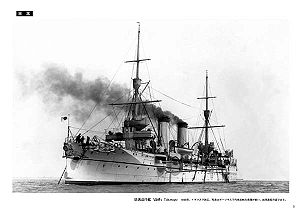Japanese cruiser Takasago
 Takasago
| |
| History | |
|---|---|
| Name | Takasago |
| Ordered | 1896 Fiscal Year |
| Builder | Armstrong Whitworth, United Kingdom |
| Laid down | April 1896 |
| Launched | 18 May 1897 |
| Completed | 17 May 1898 |
| Out of service | 13 December 1904 |
| Fate | Mined off Port Arthur 13 December 1904 |
| General characteristics | |
| Type | Protected cruiser |
| Displacement | 4,160 long tons (4,227 t) |
| Length | 118.2 m (387 ft 10 in) w/l |
| Beam | 14.78 m (48 ft 6 in) |
| Draft | 5.18 m (17.0 ft) |
| Propulsion | 2-shaft VTE; 12 boilers; 15,500 hp (11,600 kW); 1,000 tons coal |
| Speed | 23.5 knots (27.0 mph; 43.5 km/h) |
| Complement | 425 |
| Armament |
|
| Armor |
|
Takasago (高砂, literally, High Sand, antiquated Japanese name for
Background


Takasago was an improved design of the Argentine Navy cruiser Veinticinco de Mayo designed by Sir Philip Watts, who was also responsible for the design of the cruiser Izumi and the Naniwa-class cruisers. The Chilean Navy cruiser Chacabuco was the sister ship to Takasago; the Japanese cruiser Yoshino was sometimes also regarded as a sister ship to Takasago, due to the similarity in their design, armament and speed, although the two vessels were of different classes.
Takasago was
Design
Takasago was a typical Elswick cruiser design, with a steel hull, divided into 109 waterproof compartments, a low
The
Service record
The first overseas deployment of Takasago was in 1900, to support Japanese
On 7 April 1902, Takasago and
Russo-Japanese War
With the start of the
On 10 March 1904, Takasago participated in an attack on the Russian cruiser Bayan. On 15 May, she participated in the rescue of survivors from the battleships Yashima and Hatsuse, which had struck naval mines. Takasago was also in the Battle of the Yellow Sea on 10 August.
She returned to Japan for overhaul in October 1904. On returning to station on the night of 13 December 1904 after a reconnaissance mission during which it provided cover for a squadron of destroyers,
Gallery
-
At Portsmouth
-
At Portsmouth
-
In Taiwan
-
In 1896
Notes
- ^ Brooke, Warships for Export
- ^ a b Chesneau, Conway's All the World's Fighting Ships 1860–1905, page 229.
- ^ http://www.walesonline.co.uk/videos-and-pics/photos/news-pictures/2008/11/27/tramcars-of-wales-91466-22353688/i14/ [dead link]
- ^ "1906 Institution of Mechanical Engineers: Visits to Works - Graces Guide". www.gracesguide.co.uk. Retrieved 26 February 2023.
- ^ Connaughton, Rising Sun and Tumbling Bear page 33
- ^ Willmont, The Last Century of Sea Power page 98
- ^ Kusnezov, Reeds in the Wind page 43
References
- Brooke, Peter (1999). Warships for Export: Armstrong Warships 1867-1927. Gravesend, UK: World Ship Society. ISBN 0-905617-89-4.
- Chesneau, Roger (1979). Conway's All the World's Fighting Ships 1860–1905. Conway Maritime Press. ISBN 0-85177-133-5.
- ISBN 0-304-36657-9.
- Evans, David C. & ISBN 0-87021-192-7.
- Jentschura, Hansgeorg; Jung, Dieter & Mickel, Peter (1977). Warships of the Imperial Japanese Navy, 1869–1945. Annapolis, Maryland: United States Naval Institute. ISBN 978-0-87021-893-4.
- Milanovich, Kathrin (2023). "Takasago, Kasagi and Chitose: The IJN's First 8in-Gun Protected Cruisers". In Jordan, John (ed.). Warship 2023. Oxford: Osprey Publishing. pp. 65–80. ISBN 978-1-4728-5713-2.
- Roberts, John (ed). (1983). 'Warships of the world from 1860 to 1905 - Volume 2: United States, Japan and Russia. Bernard & Graefe Verlag, Koblenz. ISBN 3-7637-5403-2.
- Schencking, J. Charles (2005). Making Waves: Politics, Propaganda, And The Emergence Of The Imperial Japanese Navy, 1868-1922. Stanford University Press. ISBN 0-8047-4977-9.
- Willmont, H. P. (2009). The Last Century of Sea Power: From Port Arthur to Chanak, 1894-1922. Indiana University Press. ISBN 978-0-253-35214-9.
- Kusnezov, Nikita (2011). Reeds in the Wind. Createspace. ISBN 978-1-4565-5309-8.



